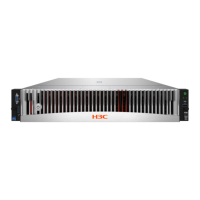42
Q Liquid cooling Dedicated for liquid cooling servers.
This table is for reference only. For detailed information, see the Inter official website.
DIMMs
For information about DIMM installation guidelines, see "DIMMs."
SAS/SATA drives
The drives are hot swappable. If you hot swap an HDD repeatedly within 30 seconds, the system
might fail to identify the drive.
If you are using the drives to create a RAID, follow these restrictions and guidelines:
• To avoid degraded RAID performance or RAID creation failures, make sure all drives in the
RAID are the same type (HDDs or SSDs) and have the same connector type (SAS or SATA).
• For efficient use of storage, use drives that have the same capacity to build a RAID. If the drives
have different capacities, the lowest capacity is used across all drives in the RAID.
• If one drive is used by several logical drives, RAID performance might be affected and
maintenance complexities will increase.
• If the installed drive contains RAID information, you must clear the information before
configuring RAIDs. As a best practice, install drives that do not contain RAID information.
NVMe drives
The server supports U.2 and E1.S NVMe drives.
Support for hot removal and managed hot removal of NVMe drives varies by operating system. For
more information, use the OS compatibility lookup tool at
http://www.h3c.com/en/home/qr/default.htm?id=65
. For more information, see NVMe Drives Online
Replacement User Guide.
If an operating system supports hot swapping of NVMe drives, follow these guidelines:
• Insert NVMe drives steadily without pauses to prevent the operating system from being stuck or
restarted.
• Do not hot swap multiple NVMe drives at the same time. As a best practice, hot swap NVMe
drives one after another at intervals longer than 30 seconds. After the operating system
identifies the first NVMe drive, you can hot swap the next drive. If you insert multiple NVMe
drives simultaneously, the system might fail to identify the drives.
If you are using the drives to create a RAID, follow these restrictions and guidelines:
• For efficient use of storage, use drives that have the same capacity to build a RAID. If the drives
have different capacities, the lowest capacity is used across all drives in the RAID. A drive with
extra capacity cannot be used to build other RAIDs.
• As a best practice, install drives that do not contain RAID information.

